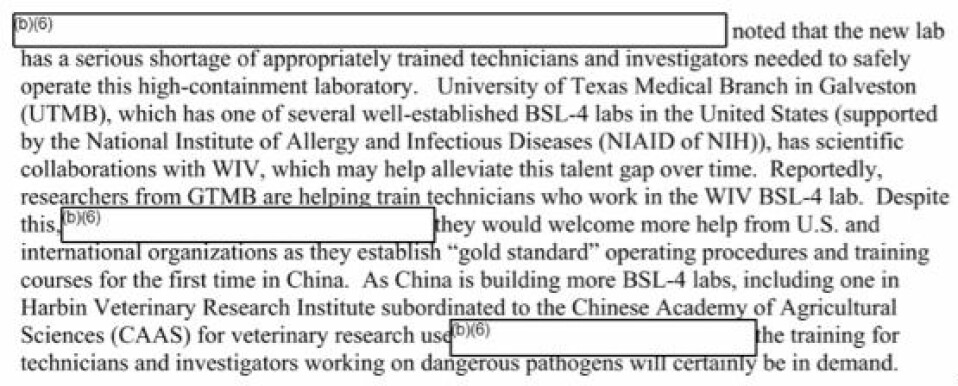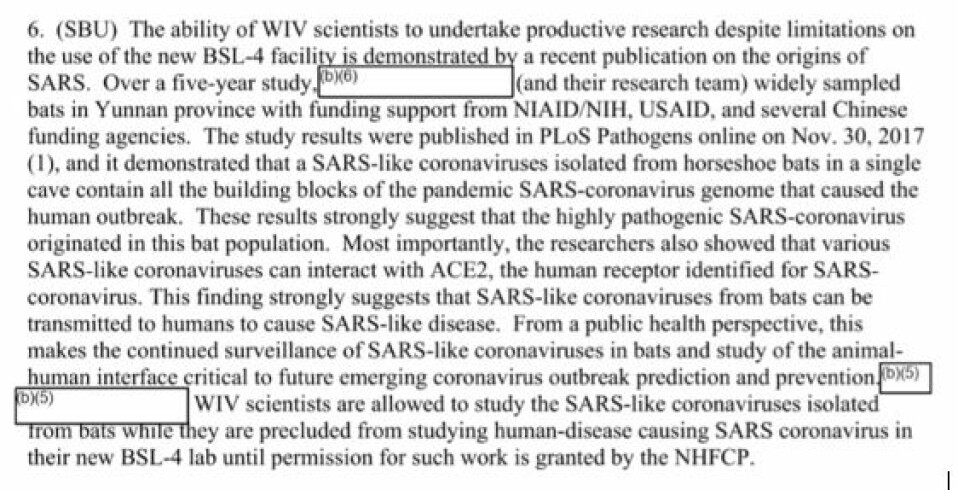For å lese pluss-artikler må du være abonnent
Et abonnement gir tilgang til alt innhold og vi har følgende tilbud
NYHET

In March 2004, it happened again. A 26-year-old laboratory researcher got infected with SARS Coronavirus while she worked for two weeks at the Chinese National Institute of Virology in Beijing.
Before the breach of safety at the Beijing lab was discovered, the researcher subsequently infected her mother, who died, and a 20-year-old nurse in a Beijing hospital where she was being treated. In turn, the nurse infected her mother, father, aunt, and a fellow patient.
Almost 1,000 people were eventually placed in quarantine or under close medical supervision before the contagion finally came under control.
In the early years after the first SARS-epidemic was contained, the World Health Organization (WHO) was particularly worried about these incidents starting a new SARS-epidemic.
In a statement from 2003, the organisation issued new guidelines for the handling of SARS-CoV specimens, along with a stark warning:
«The possibility that a SARS outbreak could occur following a laboratory accident is a risk of considerable importance, given the relatively large number of laboratories currently conducting research using the SARS-CoV or retaining specimens from SARS patients. These laboratories currently represent the greatest threat for renewed SARS-CoV transmission through accidental exposure associated with breaches in laboratory biosafety», the WHO wrote in the accompanying statement.
The call for increased laboratory safety had an important impact and laboratory safety was significantly strengthened in the aftermath of the Beijing incident. No further incidents of the first SARS-Coronavirus escaping laboratory containment has ever been reported.
In 2003, the Chinese Academy of Sciences also approved the construction of China’s first biosafety level 4 laboratory in Wuhan, which was put into operation in 2018, becoming the first Chinese laboratory to operate at the highest level of laboratory safety.
The ambitions for the new lab and its researchers at the Wuhan Institute of Virology were high: To search for and prevent the next human pandemic, with a specialized focus on coronaviruses.
But according to an embassy cable authored by American diplomats that visited the facility, the ambitions of the lab were set back due to a lack of appropriately trained staff to securely operate the lab and approvals, but nevertheless made progress with coronavirus research:

The scientists at WIV were therefore, according to the embassy cable ,«only allowed to study the SARS-like coronaviruses isolated from bats, while they are precluded from studying human-disease causing SARS coronaviruses in their BSL-4 lab».

According to later statmenent by Dr. Shi Zhengli at the Wuhan Institute, the coronavirus research at the Wuhan lab was therefore conducted at the lower security levels BSL 2 and BSL 3 prior to the recent coronavirus pandemic.
Since the outbreak of SARS-CoV-2, the US administration led by President Donald Trump has on numerous occasions indicated that they believe the virus originated in a laboratory, but without offering any evidence to support the claim.
WHO has recently released its plan to investigate the origins of the COVID pandemic. The mandate for investigation is given by a resolution passed by the WHO general assembly that tasks the researchers with identifying “the zoonotic source of the virus and the route of introduction to the human population.» The final draft of the “WHO-convened Global Study of the Origins of SARS-CoV-2” does not mention lab origin as a target of the investigation.
The search will start in Wuhan – the Chinese city where SARS-CoV-2 was first identified – and expand across China and beyond.
Asked whether or not the WHO still considers laboratory accidents to be «a risk of considerable importance» as the organisation stated in 2003, a spokesperson for the WHO responds:
«The post-outbreak biosafety guidelines in question were published in following up reports of laboratory-acquired accidents that happened only a couple of months after the announcement of the end of the SARS outbreak. WHO and its Member States took these events very seriously and adopted a World Health Assembly resolution on enhancement of biosafety in 2005, leading to much improved awareness and practices».
«Since then, there has been no report of inadvertent release or infection of SARS-CoV. The context of the guidelines, therefore, is not directly related to the present outbreak caused by a different and novel pathogen now known as SARS-CoV-2», the WHO goes on explaining.
The WHO is, however, open to investigating the possibility that the recent SARS-Cov-2 outbreak started as a laboratory accident:
«The studies into the virus origins will look into all options. If initial studies point towards a lab role, this will be looked into. However, it cannot be compared to the situation in 2003, where laboratory accidents implicated laboratories knowingly handling the SARS-CoV virus. This time around, no laboratories are known to have knowingly handled this virus prior to the end of 2019», a spokesperson stated.
The question of whether or not labs have held and worked with viruses that either is SARS-CoV-2 or very closely resembles it, is another subject.
Two lab freezers in Asia have recently yielded some unexpected discoveries. In an article posted in Nature, researchers have reported that they have found a coronavirus that is closely related to SARS-CoV-2, the virus responsible for the pandemic, in horseshoe bats stored in a freezer in Cambodia. A team in Japan has reported a similar finding of another closely related coronavirus. However, no data on potential infectivity of the new strains for humans are yet given.
These findings indicate that researchers might need to look beyond China and Wuhan to track down the source that has transmitted the SARS-CoV-2 virus to humans.
But when considering the inventory of the virus lab in Wuhan, it is the other way around. The lab´s proximity to the initial outbreak looks suspicious to many when combined with indications that they stored viruses that could easily have been developed into the SARS-CoV-2 virus.
The genetic structure of SARS-CoV-2 makes a lab origin impossible to dismiss, Italian and Russian-Canadian researchers Rossana Segreto and Yuri Deigin argue in a recent article published in the peer-reviewed journal BioEssays. This is in sharp contrast with the analysis presented by Kristian Andersen in the Proximal Origin of SARS-CoV-2 published in Nature at the beginning of the pandemic. Beside describing peculiar genetic features of the virus, the authors point out a series of incongruences regarding key samples used to support its natural origin.
One of the arguments presented by Segreto and Deigin relates to the closest known relative of the SARS-CoV-2 virus, namely the RaTG13 virus, which was first described in the Nature article “A pneumonia outbreak associated with a new coronavirus of probable bat origin,” that was authored by the research team in Wuhan and published in February 2020.
The RaTG13 virus is 96,2 percent identical to the SARS-CoV-2 virus and was the closest related virus to SARS-CoV-2 known at the time of publishing.
«This sequence basically came out of nowhere», Segreto explains to Minerva.
But not only did it come out of nowhere. Segreto and Deigin also believe that the origins of the sequence has not been clearly described. «In the article that first mentioned the RaTG13 sequence, the authors failed to mention which sample the virus was collected from, and made it sound like they have never sequenced its full genome prior to the start of the pandemic» Deigin elaborates.
Segreto and Deigin consider this to be of special significance, since it has later been discovered that this sample was collected from a mine in Yunnan where six miners came down with severe pneumonia that killed three of them in 2012.
The cause of disease in the miners is still a mystery. The world-known virologist Shi Zhengli at Wuhan Institute of Virology (WIV) has earlier stated that the disease was caused by a fungus.
However, this information has since been contrasted to the accounts in Chinese-language MSc and a PhD thesis which were brought to international attention by an anonymous Twitter user. These theses claim that the miners most likely suffered from an infection from an unknown coronavirus and has fuelled speculations on whether the Wuhan Institute of Virology (WIV) prior to the start of the pandemic had stored and worked with a coronavirus that either is SARS-CoV-2 or that can easily be manipulated into becoming the novel coronavirus.
Segreto and Deigin point out that the Wuhan-based authors of the Nature article “A pneumonia outbreak associated with a new coronavirus of probable bat origin” make no indication that the sequence was worked upon by the Wuhan research lab prior to the start of the pandemic, but did instead write: «We then found that a short region of RNA-dependent RNA polymerase (RdRp) from a bat coronavirus (BatCoV RaTG13) —which was previously detected in Rhinolophus affinis from Yunnan province — showed high sequence identity to 2019-nCoV. We carried out full-length sequencing on this RNA sample», implying that this virus had not been sequenced before the pandemic started.
This interpretation of the wording in the article has also been mirrored by a close collaborator to the Wuhan Institute of Virology, Dr. Peter Daszak, the President of EcoHealth Alliance.
In an interview for the NY Times in April, Daszak stated that they found «the closest relative to the current SARS-CoV-2 in a bat in China in 2013» and added:” We sequenced a bit of the genome, and then it went in the freezer; because it didn’t look like SARS, we thought it was at a lower risk of emerging.»
But the interpretation by Daszak would also soon come under scrutiny.
The following month, the Wuhan Institute of Virology uploaded the raw data from the sequencing of the RaTG13 genome, and this data contained files that pointed to something else.
«Some of the file names that were stored by the software users to sequence the virus indicated that the sequencing of the virus occurred in 2017 and 2018», Segreto and Deigin explained to Minerva.
And when Shi Zhengli was interviewed by Science Mag in July, she gave a new explanation as to why this virus was sequenced: «In 2018, as the NGS sequencing technology and capability in our lab was improved, we did further sequencing of the virus using our remaining samples and obtained the full-length genome sequence of RaTG13 except the 15 nucleotides at the 5’ end. As the sample was used many times for the purpose of viral nucleic acid extraction, there was no more sample after we finished genome sequencing, and we did not do virus isolation and other studies on it», Shi Zhengli told Science Mag.
In Segreto and Deigin´s recently published article, they call on the Wuhan team to clarify what actually happened: «The reversal in WIV’s stance on when exactly RaTG13 was fully sequenced could have been due to the discovery by independent researchers into the origins of SARS-CoV-2 that the filenames of the raw sequencing reads deposited by WIV on May 19, 2020 seem to indicate that sequencing for RaTG13 was done in 2017 and 2018. However, no formal erratum about the year of sequencing and sample renaming from the authors of Zhou et al. have yet appeared, or as far as is currently known, have been submitted».
A response to the criticism posited by Segreto and Deigin appeared in Nature on the very same day their article was published in BioEssays, the 17th of November, which coincidentally also marks the one-year anniversary for the SARS-CoV-2 index case.
In an addendum to “A pneumonia outbreak associated with a new coronavirus of probable bat origin,” published by Nature, the authors clarify that the RaTG13 sequence was collected from the same mine that the sickened miners had ventured into.
It also makes clear that samples from the sick miners have been stored and now retested for SARS-CoV-2 and confirmed that “these patients were not infected by SARS-CoV-2,»hence, dismissing the idea that the miners suffered from Covid-19.
On why and when the RaTG13 virus was sequenced, the addendum writes in contrast to the original article the following statement: «in 2018, as the next-generation sequencing technology and capability in our laboratory had improved, we performed further sequencing of these bat viruses and obtained almost the full-length genome sequence (without the 5′ and 3′ ends) of RaTG13.»
Given the disagreement on how the original article is supposed to be interpreted, Minerva has asked Nature to clarify whether or not they consider the content of the original article to be incorrect as to why and when the RaTG13 virus was sequenced. On this question a spokesperson from Nature responds:
«We appreciate that, given global events, the methodology of this paper is of particular interest and we are committed to ensuring that we carefully assess issues raised with us and responses from the authors, and ensure that clarity is provided to our readership. When we were contacted about this issue, we considered it very carefully and concluded that the original paper was insufficiently clear about when the full-length sequencing of the bat virus was performed. Our addendum format provides a vehicle for publishing clarification or significant additional information necessary for readers’ understanding of an article, whereas we would generally publish a correction if there was an error in an article that affected its scientific integrity or the scientific record. In this case, we concluded that publishing an addendum was the most appropriate course of action, given that the original description of the timing of the sequencing was not inaccurate but was unclear»
Asked about whether Nature has received any additional information from the authors of the article on why the original article indicated that the virus was only sequenced after the discovery of SARS-CoV-2, Nature informs that they treat all correspondence submitted to the journal as confidential.
Vegard Eldholm is a senior scientist at the Norwegian Institute of Public Health who has actively participated in the debate on SARS-CoV-2 origins and the RaTG13 sequence. He believes the addendum provides credible sufficient clarifications from the Wuhan scientists:
«This addendum is a response to the massive rise of conspiracies around RaTG13 and an outbreak of serious lung disease among miners in Mojiang, Yunnan. I think this clarification seems credible, perhaps mostly because it is precisely this course of events that I have counted as most likely all the way».
He does however not consider it to have much impact on the ongoing debate on whether or not the virus originated in the Wuhan lab:
«I do not think the update will have much to say for the discourse further among conspiracy theorists. No evidence is presented, only a clarification of the order of various findings and analyses», Eldholm elaborates.
When Deigin and Segreto are asked about whether they are conspiracy theorists, Deigin denies it: «Although there are many conspiracy hypotheses involving a lab release, that does not mean that all hypotheses that involve a lab leak are conspiracies”.
«You can consider it as a range of theories and explanations, whereby some of them are indeed far-fetched, but others are quite plausible in light of available evidence and considering also that lab leaks of pathogens are not rare events », he elaborates.
Deigin and Segreto do however agree that there is no conclusive evidence either way: neither for a natural origin, nor for a lab leak, but the absence of a credible zoonotic scenario a whole year after the outbreak, when combined with various peculiarities of the virus and the way WIV and its collaborators have behaved, make Segreto and Deigin very surprised.
«When you consider the fact that an outbreak occurred in Wuhan, which is a thousand miles away from where these viruses are found naturally, combined with the fact that WIV have been actively collecting such coronaviruses for many years and then modifying them in the lab; when you also look at the history of other, worldwide lab accidents, and finally match this up with the lack of transparency from Chinese authorities – all that together makes one highly suspicious that a lab leak might have occurred in Wuhan», Deigin says.
Regarding the information given in the addendum, Segreto and Deigin feel vindicated and insist that there is still more information that WIV should release – for example, what are the other eight SARS-like coronaviruses that WIV claims to have collected from the Mojiang mine and full sequenced together with RaTG13?
The authors also wonder why WIV didn’t re-test the miners’ samples for SARS antibodies, because the 2016 Huang PhD thesis reported that back in 2013, WIV confirmed the presence of IgG SARS antibodies in 4 miners’ samples.
«One of the key questions that we have to ask is: why is information released by WIV in such a limited and often not clear way?», Segreto adds. In her view «there should be no scientific reason for not sharing all relevant information regarding the pandemic and all related viruses up front. When this is not done, the reasons might be political, not scientific».